Seaborn Kdeplot - подробное руководство
График оценки плотности ядра (KDE) и график Kdeplot позволяют нам оценить функцию плотности вероятности непрерывного или непараметрического из нашей кривой набора данных в одном или нескольких измерениях, это означает, что мы можем создать один график для нескольких выборок, который помогает в большем количестве эффективная визуализация данных.
Чтобы использовать модуль Seaborn, нам необходимо установить модуль, используя следующую команду:
pip install seaborn
Syntax: seaborn.kdeplot(x=None, *, y=None, vertical=False, palette=None, **kwargs)
Parameters:
x, y : vectors or keys in data
vertical : boolean (True or False)
data : pandas.DataFrame, numpy.ndarray, mapping, or sequence
Мы изучаем использование некоторых параметров на некоторых конкретных примерах:
First import the corresponding library
Python3
import pandas as pdimport seaborn as sbimport numpy as npfrom matplotlib import pyplot as plt%matplotlib inline |
Draw a simple one-dimensional kde image:
Let’s see the Kde of our variable x-axis and y-axis, so let pass the x variable into the kdeplot() methods.
Python3
# data x and y axis for seabornx= np.random.randn(200)y = np.random.randn(200) # Kde for x varsns.kdeplot(x) |
Выход:
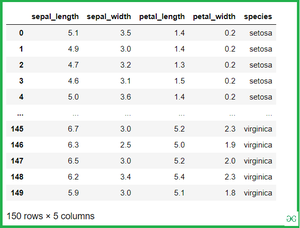
Then after check for y-axis.
Python3
sns.kdeplot(y) |
Выход:
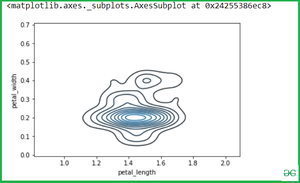
Используйте Shade, чтобы заполнить область, покрытую кривой:
We can highlight the plot using shade to the area covered by the curve. If True, shadow processing is performed in the area below the kde curve, and color controls the color of the curve and shadow
Python3
sns.kdeplot(x, shade = True) |
Выход:
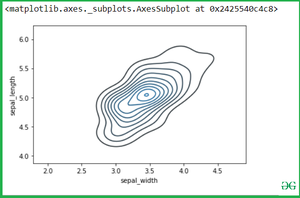
You can change the Shade color with color attributes:
Python3
sns.kdeplot(x, shade = True , color = "Green") |
Выход:
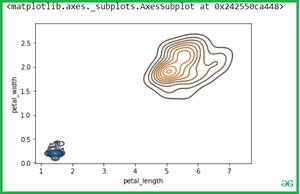
Use Vertical to draw indicates whether to draw on the X axis or on the Y axis
Python3
sns.kdeplot(x, vertical = True) |
Выход:
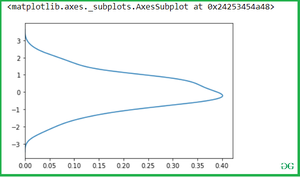
Двумерный график Kdeplot для двух переменных:
Simple pass the two variables into the seaborn.kdeplot() methods.
Python3
sns.kdeplot(x,y) |
Выход:

Shade the area covered by a curve with shade attributes:
Python3
sns.kdeplot(x,y, shade = True) |
Выход:
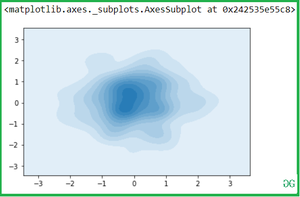
Now you can change the color with cmap attributes:
Python3
sns.kdeplot(x,y, cmap = "winter_r") |
Выход:
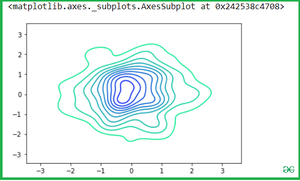
Use of Cbar: If True, add a colorbar to annotate the color mapping in a bivariate plot. Note: Does not currently support plots with a hue variable well.
Python3
sns.kdeplot(x, y, shade=True, cbar=True) |
Выход:
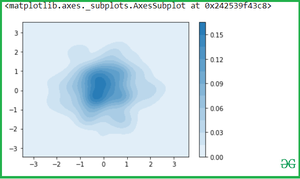
Давайте посмотрим на пример с набором данных Iris, который представляет собой график распределения для каждого столбца набора данных широкой формы:
Набор данных ирисов состоит из трех разных типов ирисов (Setosa, Versicolour и Virginica), длина лепестков и чашелистиков, хранящихся в numpy.ndarray размером 150 × 4.
Loading the iris dataset for Kdeplot:
Python3
iris = sns.load_dataset("iris")iris |
Выход:

Двумерный график Kdeplot для двух переменных радужной оболочки:
Once we have species set then if we want to simply calculate the petal_length and petal_width then Simple pass the two variables(Setosa and verginica ) into the seaborn.kdeplot() methods.
Python3
setosa = iris.loc[iris.species=="setosa"]virginica = iris.loc[iris.species == "virginica"]sns.kdeplot(setosa.petal_length, setosa.petal_width) |
Выход:

See another example if we want to calculate another variable attribute which is sepal_width and sepal_length.
Python3
sns.kdeplot(setosa.sepal_width, setosa.sepal_length) |
Выход:

If we pass the two separate Kdeplot with different variable:
Python3
sns.kdeplot(setosa.petal_length, setosa.petal_width)sns.kdeplot(virginica.petal_length, virginica.petal_width) |
Выход:

Внимание компьютерщик! Укрепите свои основы с помощью базового курса программирования Python и изучите основы.
Для начала подготовьтесь к собеседованию. Расширьте свои концепции структур данных с помощью курса Python DS. А чтобы начать свое путешествие по машинному обучению, присоединяйтесь к курсу Машинное обучение - базовый уровень.